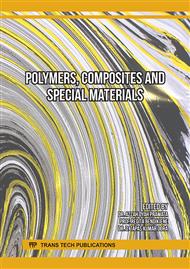[1]
Polyolefin composites, Ed. By Domasius Nwabunma and Thein Kun 3M Company,Wiley- Interfacescience, A. John Wiley and Sons INC Publications, 2007.
Google Scholar
[2]
S. Chaudemache, A. Perrot, S. Pimbert, T. Lecompte, F. Fame, Properties of industrial extruded HDPE-WPC: The effect of the size distribution of wood flour particles, Constr. Build. Mater. 162 (2018) 543-552
DOI: 10.1016/j.conbuildmat.2017.12.061
Google Scholar
[3]
J. Kajaks, A. Kolbins, K. Kalnins, Some exploitation properties of wood plastic composites (WPC) based on high density polyethylene and plywood production waste, IOP Conf. Series: Materials Science and Eng. 111 (2016) 012003
DOI: 10.1088/1757-899X/111/1/012003
Google Scholar
[4]
C. Fonseca-Valero, A. Ochoa-Mendoza, J. Avranz-Andres, C. Gonzalez-Sanchez, Mechanical recycling and composition effects on the properties and structure of hard wood cellulose reinforced high density polyethylene eco-composites, Composites: Part A. 69 (2015) 94-104
DOI: 10.1016/j.compositesa.2014.11.009
Google Scholar
[5]
J. Kajaks, K. Kalnins, R. Naburgs, Wood plastic composites (WPCs) based on high density polyethylene and birch wood plywood production residues, Intern.Wood Products Journal. 9 (1) (2018) 15-21
DOI: 10.1080/20426445.2017.1410997
Google Scholar
[6]
J. Kajaks, A. Zagorska, A. Mezinskis, Some exploitation properties of wood plastic composites (WPC) based on high density polyethylene and timber industry waste, J. of Mater. Science. 21(3) (2015) 396-399
DOI: 10.5755/j01.ms.21.3.7283
Google Scholar
[7]
H. Chen, T. Chen, C. Hsu, Effects of wood particle size and mixing ratios of HDPE on the properties of the cComposites, Holz als Roh-und Werkst. 64(3) (2006) 172-177
DOI: 10.1007/s00107-005-0072-x
Google Scholar
[8]
H. Jaya, M. Omar, H. Md Akil, Z. Arifin Ahmad, N. Zulkeplin, Effect of Particle size on mechanical properties of sawdust-high density polyethylene composites under various strain rates, BioResources. 11(3) (2016) 6489-6504. https://doi.org:
DOI: 10.15376/biores.11.3.6489-6504
Google Scholar
[9]
E. Nadali, M. Layeghin, G. Ebrahimi, R. Naghdi, M. Jonoobi, M. Mehdi Khorasani, Y. Mirbagheri, Effects of multiple extrusions on structure-property performance of natural fiber high-density polyethylene biocomposites, Mater. Res. 21(2) (2018) 101-110
DOI: 10.1590/1980-5373-MR-2017-0301
Google Scholar
[10]
H. Kuan, J. Huang, C. Ma, F. Wang, Processability, morphology and mechanical properties of wood flour reinforced high density polyethylene composites, Plast. Rubber Compos. 32(3) (2003) 122-126
DOI: 10.1179/146580103225001363
Google Scholar
[11]
W. Brostow, T. Datashvili, P. Jiang, H. Miller, Recycled HDPE reinforced with sol-gel silica modified wood sawdust, Europ. Polym. Journal. 76 (2016) 28-39. https://dx.doi.org/10.1016/j.eurpolymj.2016.01.0150014-3057/Ó (2016)
DOI: 10.1016/j.eurpolymj.2016.01.015
Google Scholar
[12]
S. Ghani, M. Pisal, F. Zainuddin, H. Ismail, The effect of chemical modification of wood properties of recycled high density polyethylene/wood fibres composites, J. of Phys. Sci. 27(1) (2016) 1-14.
Google Scholar
[13]
J. Kajaks, K. Kalnins, A. Zagorska, J. Matvejs, Some exploitation properties of wood plastic composites based on recycled high density polyethylene (rHDPE) and plywood production residues, Solid State Phenome. 267 (2017) 76-81
DOI: 10.4028/www.scientific.net/SSP.267.76
Google Scholar
[14]
A. Turku, T. Keskisaari, A. Karki, A. Puurtinen, P. Martttile, Characterization of wood plastic composites manufactured from recycled plastics blends, Compos. Structure. 161 (2017) 469-476
DOI: 10.1016/j.compstruct.2016.11.073
Google Scholar
[15]
A. Ashori, A. Nourbakhsh, Characteristics of wood-fiber plastic composites made of recycled materials, Waste Manag. 29(4) (2009) 1291-1295
DOI: 10.1016/j.wasman.2008.09.012
Google Scholar
[16]
A. Nourbakhsh, A. Ashori, Preparation and properties of wood plastic composites made of recycled high-density polyethylene, J. Compos. Mater. 43(8) (2009) 877-883
DOI: 10.1177/0021998309103089
Google Scholar
[17]
I. Ignatyev, W. Thieleman, B. Vander Beke, Recycling of polymers: A review, ChemSusChem. 7(6) (2014) 1579-1593
DOI: 10.1002/cssc.201300898
Google Scholar
[18]
S. Karlson, Recycled Polyolefins. Material Properties and Means for Quality Determination, Adv. Polym. Sci. 169 (2004) 201-229
DOI: 10.1007/b94173
Google Scholar
[19]
R. Mnif, R. Elleuch, Effects of reprocessing cycles and ageing on the rheological and mechanical properties of virgin-recycled HDPE blends, Mater. Tech. 103(7) (2015) 85-90
DOI: 10.1051/MATTECH/2015056
Google Scholar
[20]
P. Oblak, J. Gonzalez-Gutierrez, B. Zupančič, A. Aulova, I. Emri, Processability and mechanical properties of extensively recycled high density polyethylene, Polym. Degrad. Stab. 114 (2015) 133-145
DOI: 10.1016/j.polymdegradstab.2015.01.012
Google Scholar
[21]
C. Mählmann, I. Kipper, A. De Lawisch, D. López, Study and characterization of virgin and recycled PE/PP blends. REWAS'04 – Glob. Symp. Recycl. Waste Treat. Clean Technol. 38 (2005) 1769-1777.
Google Scholar
[22]
K. Adhikary, S. Pang, P. Staiger, Dimensional stability and mechanical behavior of wood plastic composites based on recycled and virgin high density polyethylenes, Composites: Part B. 39 (2008) 807-815
DOI: 10.1016/j.compositesb.2007.10.005
Google Scholar
[23]
J. Kajaks, K. Kalnins., M. Zalitis, J. Matvejs, Some exploitation properties of wood plastics composites based on mixtures of virgin and recycled high density polyethylenes and birch plywood sanding dust, Solid State Phenom. 320 (2021) 119-125
DOI: 10.4028/www.scientific.net/SSP.320.119
Google Scholar
[24]
A. Van Belle, R. Demets, N. Mys, K. Van Kets, J. Dewulf, K. Van Geen, S. De Meester, K. Ragaert, Microstructural contributions of different polyolefins to the deformation mechanisms of their binary blends, Polymers. 12(5) (2020) 1171
DOI: 10.3390/polym12051171
Google Scholar
[25]
H. Gao, Y. Xie, R. Ou, Q. Wang, Grafting effects of polypropylene/polyethylene blends with maleic anhydride on the properties of the resulting wood-plastic composites, Compos. Part A: Appl. Sci. Manuf. 43(1) (2012) 150-157
DOI: 10.1016/j.compositesa.2011.10.001
Google Scholar
[26]
M. Fatima Ezzahrae, A. Nacer, E. Latifa, I. Mohamed, Z. Abdellash, J. Mustapha, Thermal and mechanical properties of a high density polyethylene (HDPE) reinforced with wood flour, Mater. To-day Proceedings. 72 (2023) 3602-3608
DOI: 10.1016/j.matpr.2022.08.394
Google Scholar
[27]
A. Koffi, F. Mijiyawa, D. Koffi, F. Erchiqui, L. Toubal, Mechanical properties, wettability and thermal degradation of HDPE/ with birch fiber composites, Polymers. 13(9) (2021) 1459
DOI: 10.3390/polym13091459
Google Scholar
[28]
A. Fazli, T. Stevanovic, D. Rodrique, Recycled HDPE/natural fibre composites modified with waste tire rubber: A comparison between injection and compression moulding, Polymers. 14(5) (2022) 3197
DOI: 10.3390/polym14153197
Google Scholar
[29]
Y.F. Shin, W. L. Tsai, S. Hamdiani, An environmentally friendly recycled polyethylene composites reinforced with diatomaceous earth wood fiber, Key Eng. Mater. 889 (2021) 15-26
DOI: 10.4028/www.scientific.net/KEM.889.15
Google Scholar



